
Aviation Club
by Ryan Park
The Aviation Club is a new club formed this year that helps to educate members around aspects of the field of aviation and to teach its members the mechanics and engineering behind aviation. It was founded by Aviation Club president, Solomon Sharp, who answered a few questions recently in order to encourage students to join. The club meets every Wednesday after school in Mr. Bradfield’s room, located in W30.
When simulating a version of flight, the Aviation Club uses multiple tools in order to have members experience the closest thing to real flight. They have multiple tools that have been programmed to act like the real tools you would find in an aircraft such as the yoke, also known as the control stick. The yoke is used in order to control the movement of the aircraft inside the simulators.
What is the purpose of your club?
The Aviation Club is based on educating our members about all aspects of aviation as a whole and teaching them how to use flight simulation technology. As the world is in high demand for pilots and engineers, having knowledge and experience in the field is an important foundation when choosing a career related to aviation. Being involved with aircraft requires many different skills, many of which are applicable to everyday life, and none are exclusive to a specific field. When I started my training as a pilot several years ago, I realized how much I wanted to share this world with other people wanting to take that first step, and how beneficial it could be to their lives.
What is some background info about your club?
A technical and mechanical understanding of aircraft, such as understanding the science of how a vehicle flies and what comes with it, is important not only for engineers but for pilots as well. Flying requires a fundamental understanding of the machine you are commanding and by having that understanding, you can be that much more effective. Aerodynamics, engine mechanics, electronics, and more all go beyond aviation and can be applied in many different fields. One of the most important skills in the world of aviation, though, is of teamwork. Every pilot, engineer, and mechanic all work in conjunction with one another, and none can work with a missing link.
What are some major projects you plan on releasing?
This year, one of our goals is to get everyone hands-on experience with real aircraft, both for maintaining them and flying them. We have already formed strong connections with professional aviators, and the date is currently being coordinated for these goals to be achieved. We are also shooting for designing a remote control model for a plane/drone and constructing it to demonstrate the effectiveness of our design.
What would you say to people interested in your club?
To anyone who is interested in the club, feel free to come and check it out! If you want to see what we’re up to, come to Mr. Bradfield’s room on Wednesdays after school and you might catch us on the simulators. We would love to have new members, and if anyone is interested in joining, come and let me know!


 Club pictures
Club pictures
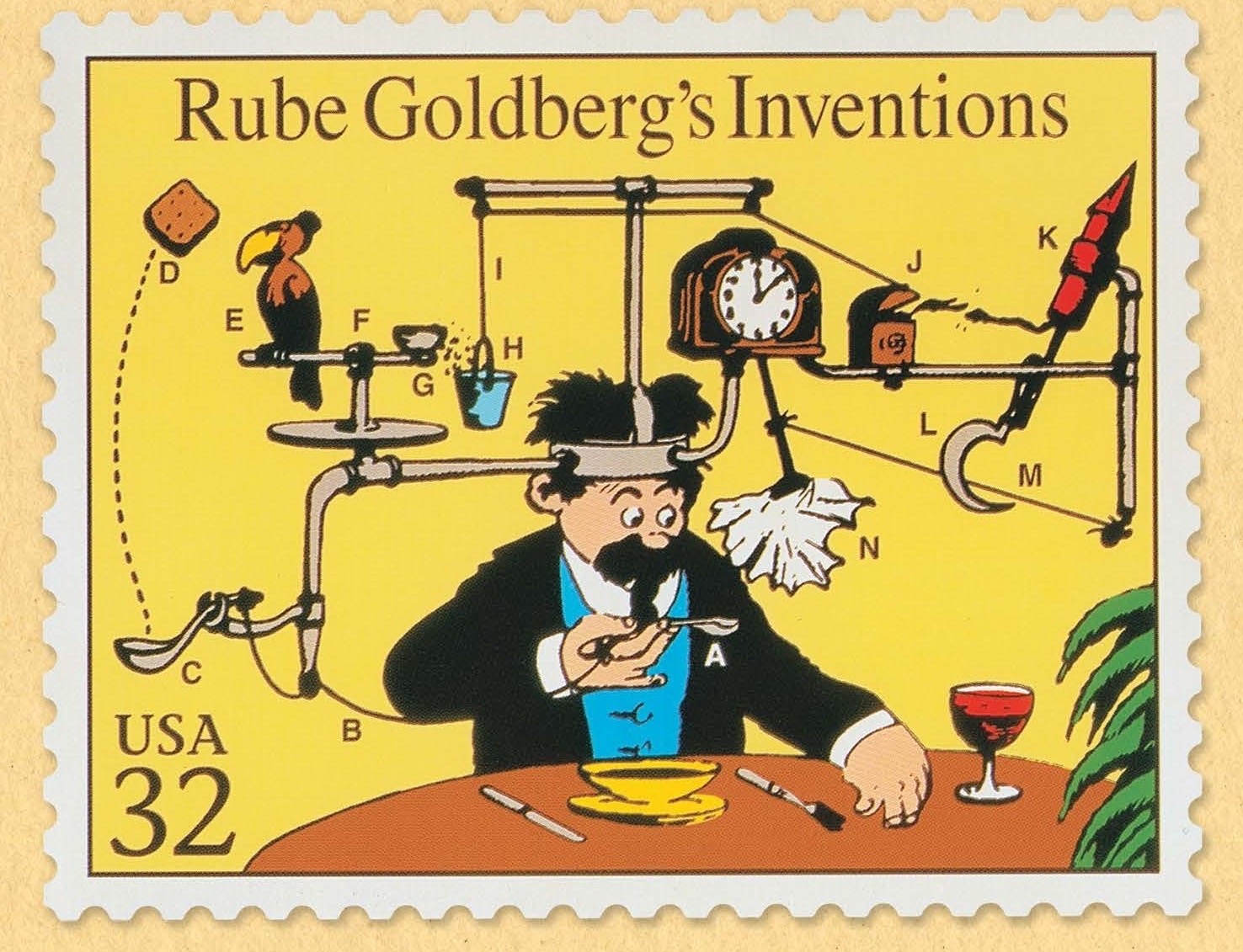
Rube Goldberg Machines Compilation
by Suren Grigorian and Daniel Svediani
The name of Rube Goldberg has become synonymous with the word “mechanism,” with his machines connoting images of complex chain reactions which accomplish a minor and relatively routine task at their end. However, the development of these machines began upon the drawing board, as the original Rube Goldberg developed a reputation for these devices through his artistic precocity.
Rube Goldberg, known originally as Reuben Lucius Goldberg, was born on July 4, 1883, to a San Francisco police and fire commissioner and a member of a Reform Jewish congregation. During his childhood, he displayed remarkable talent in the tracing of illustrations. As he grew up, his inclination toward the arts became apparent, but he was encouraged on a path of engineering by his father, graduating from the University of California, Berkeley in 1904. However, his presence in the engineering community did not last long, as he decided to pursue his original inclination for the arts. He joined the San Francisco Chronicle and the San Francisco Bulletin, gaining cartoon syndication with several newspapers.
By 1915, he became known as America’s most popular cartoonist. His most popular comic strip was The Inventions of Professor Lucifer Gorganzola, which brought him fame and is the one that we all associate with Rube Goldberg. The strip exhibited comically intricate inventions created by a Professor Butts, and these devices would later become known as Rube Goldberg machines. Later, he created a series of seven short animated films depicting the humorous aspects of everyday life.
Check out the awesome student-made Rube Goldberg machine shorts from Mr. Bradfield’s MakerSpace classes in the attached compilation above!
Original Rube Goldberg cartoons:
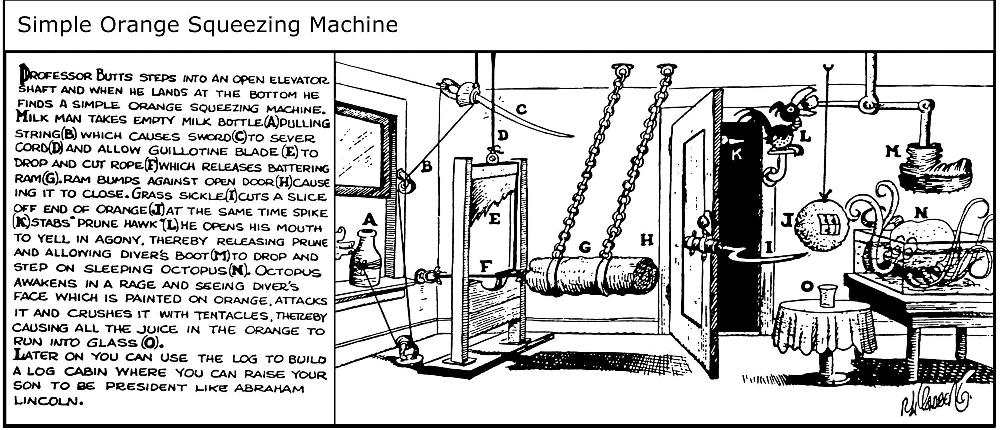


Read More

Zyg Ramsay: 3D Printing Hero
by Ms. Kincaid and David Tang
I’m sure there are many of us who read about what’s happening in the news and see how hard healthcare and frontline workers are working to keep us safe, and we wonder, “What can I do to help?” Well, 8th grader Zyg Ramsay went ahead and decided to do something about it. He saw the challenges that healthcare workers were having getting all the Personal Protective Equipment, or PPE, they needed. With a highly contagious virus like SARS-CoV-2, doctors, nurses and others must have not only masks and full gowns, but also face shields to prevent the microdroplets that could carry the virus from coming in contact with their faces. Zyg saw that Budmen Industries was looking for volunteers to help flatten the curve and protect healthcare workers by using their home 3D printers to print these face shields.
As he explains, “I was fiddling around on the internet and found the Budmen website that contains 3D printing files. You register to become a producer. They didn’t tell me what to do so I just printed one to see how it worked. I thought, “Once they email me to start printing stuff I will.” I got an email from Budmen saying there was an L.A. location, with somebody putting it together in the L.A. area, so I signed up for that. I didn’t have to design the file; you don’t code the printer’s movements, there’s a program that takes a 3D image and converts it into text which the printer follows.”


MS KINCAID: What material do you use to print the face shields?
ZYG: I use PLA [polylactic acid] for the face shields, which is a plastic made from corn, so it is biodegradable. My printer melts it at 200⁰ C and prints each of the 30 layers layer by layer, printing a complete face shield in 2 hours. There are two things I print for it. One is the actual shield in front of the face, and the other is the strap lock that keeps the elastic in place.
MS KINCAID: About much does it cost to make each one?
ZYG: I calculated it at one point, I think it’s around 12¢ of material for each one. I’ve printed 59 shields, so almost 3 kg of plastic.
I asked Zyg how he got into 3D printing. “About 2 years ago, I read about 3D printing in MAKE: magazine. My first printer cost around $200, but it was only able to print up to 4 cubic inches. I got a larger one for Christmas that can print up to 11 cubic inches.”
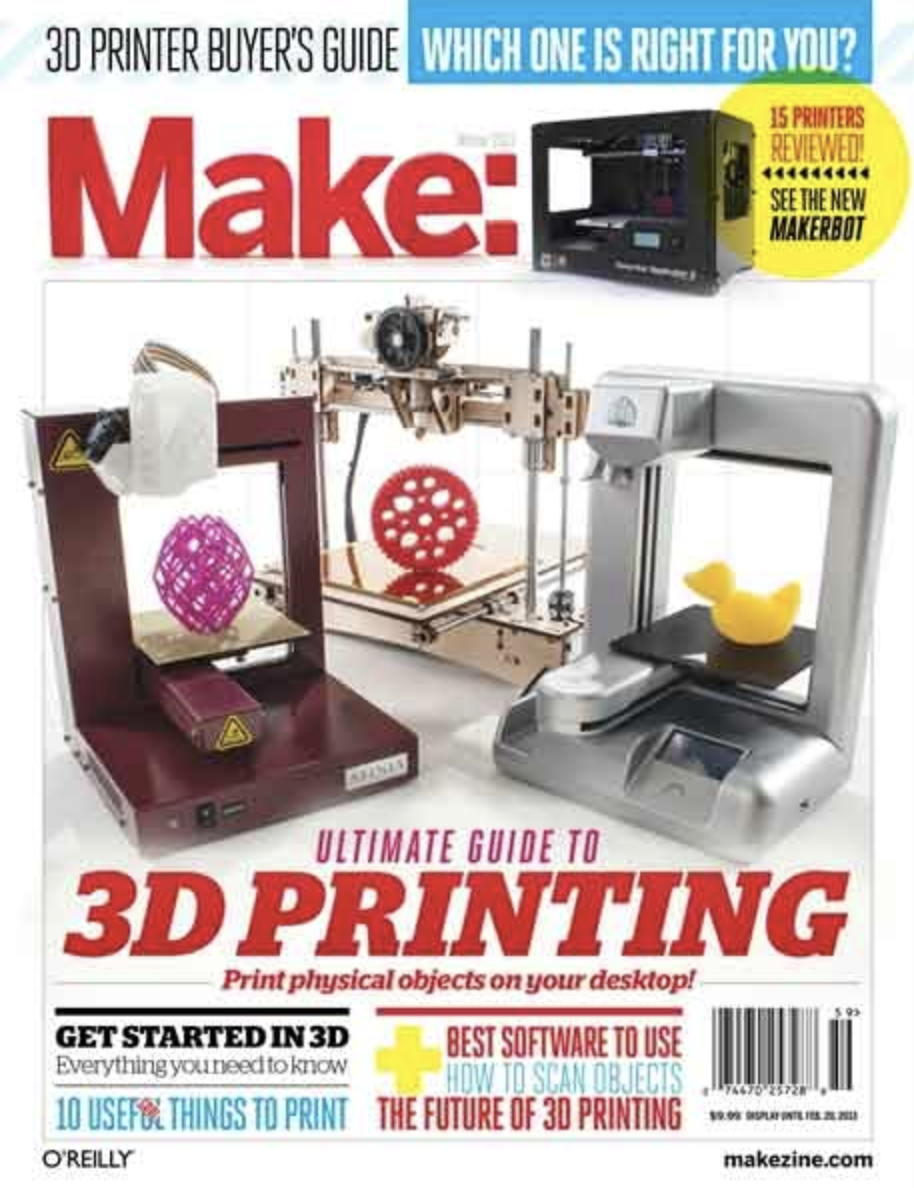
Our interview continued:
MS KINCAID: What else are you working on?
ZYG: Right now I’m working on making two drones. One is a tricopter with three propellers and servo motors to turn the propellers. From what I have read, it’s is much more stable and easier to control, but for some reason it’s less common than the quadcopter, the normal drone with a
MS KINCAID: Why do you think that the tricopter is better than the quadcopter?
ZYG: The tricopter doesn’t turn by slowing down one propeller and speeding another like the quadcopter, it turns the servo. It also doesn’t lean when it moves to the side, it stays in place, which helps people with cameras on their drones.
I’m also working on a minor soldering project. My mom bought a PCB for me, which is a superthin circuit board, and I solder super tiny electronic pieces onto the PCB with solder, which is just super easy-to-melt metal that conducts electricity.
MS KINCAID: Are you just experimenting to see if you can solder that small or are you actually trying to modify the board?
ZYG: I’m just trying to solder that small. Usually I solder bigger things but it has the soldering pads to attach components to it. The last project I’m working on is my MakerSpace project, which is the prosthetic hand controlled by muscle signals.
MS KINCAID: Can you tell us about that?
ZYG: Basically it works with 5 servos connected to string that attaches to each of the 3D printed fingers. When the servo turns one way, the finger closes, and when the servo turns the other way, the finger opens. I control it using muscle signals with a control board connected to a microcontroller like an Arduino. The part connected to the muscle uses EMG [electromyography] to measure difference in electricity between different points on the arm. It uses this EMG to figure out if the person is trying to flex or relax. This works because muscles use actin and myosin fibers, triggered by electrical impulses and powered by ATP.
MS KINCAID: What is your goal?
ZYG: I want to make a very cheap prosthetic hand where you can move each finger independent of each other. Right now your options are: a cheap one that closes all fingers at a time, which is bad for writing or holding circular objects, or an independent-digit expensive hand for around $10,000. Mine would be $150-200 but with independent digits. I would want to program patterns into it for set hand positions because it’s hard to program in each muscle.
MS KINCAID: If this is meant for someone without those muscles? Where would the signals come from?
ZYG: Right now, I control it via my forearm. This is designed for somebody who has no wrist, but still retains most of the forearm, so you can still use the muscles of the forearm. Closing and opening the hand uses muscles in the forearm, not the hand or wrist. Just using the forearm is a bit harder, but you can learn to do it. Studies have shown that with training, you can learn to use your brain to control a whole prosthetic arm.
MS KINCAID: That is cool! Would the stickers with wire be attached to your temples, then?
ZYG: You wouldn’t use the stickers, you would use the headset that goes over your head and measures alpha brain waves. You can’t really control an arm with that outside of the lab because you would have to get something implanted in your brain to control the arm, and you can’t do that outside of the laboratory.
MS KINCAID: So I guess that’s where we are today, and we’ll keep moving forward with the technology. Thanks Zyg, I feel like I learned a lot today!
ZYG: Thanks, you too! Bye!
As Mr. Bradfield, Zyg’s MakerSpace teacher commented, “It was inspiring to see Zyg applying the design and engineering principles he learned in class to a real-world problem.” It is inspiring to see our students take what they learn and help make the world a little bit better!
If you are interested in registering to 3D print face shields, learn more by clicking below:
Read More

3D Printing
How 3D Printers Work
By: Suren Grigorian and Everett Lane
3D printing is a technology which, prior to the beginning of the 21st century, remained exclusively confined to the subjects of industrial manufacturing and prototype production. It is gaining traction in the consumer/recreational world as one of the most ubiquitous and recent technologies of the early millennium; however, a large majority of those who do not have experience with 3D printing remain
The second type of standard commercial 3D printer remains the powder bed fusion type; this type is primarily characterized via a mechanism which, rather than processing and extruding material from a separate store, utilizes concentrated lasers to melt, solidify and fuse a bed of powdered material, normally polyamide plastic, into a final shape. As each fusion cycle is completed, a roller contributes additional material and the cycle begins once more; this type primarily consists of selective laser sintering, patented at the Defense Advanced Research Projects Agency in the 1980s and today the most common type. The objects produced by both types additionally possess varying textures, with the former producing granulated, coarse items and the latter producing smooth, layered and ribbed items; though texture varies, the primary factor which leads the average hobbyist to select one over the other is cost, as powder bed fusion 3D printers are more expensive than the standard fused deposition modeling types.
But what of industrial 3D printers? These 3D printers are primarily characterized via the utilization of technologies which served as the ancestors to the modern 3D printer. Some types of filaments for 3D printing are PLA and ABS, but in this case polymer will be used. These 3D printers usually make their product with a pool of liquid. This is called Stereolithography. First, a roller on the printer spreads out an extremely thin layer of liquid polymer on a platform. Since the layer is a liquid, it will spread out across the entire platform with an even distribution so each layer will have a consistent thickness. The liquid polymer is specially designed to be UV sensitive, so when it is struck with a UV laser it solidifies. Essentially the laser bra is the outlines of the build onto the platform and the places that the laser touch garden. Then the roller rolls a new layer of polymer onto the platform and the platform shifts downwards to facilitate the new layer that has been added to the platform. The process gets repeated over and over again until the build is completed. Then it lifts the newly lasered plastic up out of the resin and the remaining flows away to be used in other builds.
| PLA/Pros | Cons | ABS/Pros | Cons |
| Can be printed on a non-heated surface | Can deform because of heat | Very sturdy and hard | More damaging to the environment. |
| Smells sweet when being printed | Less sturdy than ABS | Suitable for cars and machine parts | Needs to be printed on a heated surface. |
| More environmentally friendly | Higher melting point | Releases plastic fumes when printing. | |
| Higher printing speed | Longer lifespan | More difficult to print. | |
| A lot more detail | Not suitable for using with food. |
So, after looking at this chart you can tell that if you are a recreational printer, you should go with PLA. But, if you are in a more high tech industry, ABS is the way to go. One more thing: The type of printer used has a great effect on the quality of the print. For example, if you have a budget of $200-$300 you would not be able to purchase the highest quality printer. But if your budget is $500-$1000 then you can dive into the field of serious 3D printing. The speed of the printing also affects the quality. If you’re willing to wait, you will get a better finished product of your work.
Medical uses
So, as you might have heard already there have been some breakthroughs achieved in the field of 3D printing organic matter. For example, there have been confirmed reports of 3D printed skin made with an organic printer that has already been used in transplants and large wounds. 3D printing can also be used in transplants because it is so easy to make but it is still being developed.
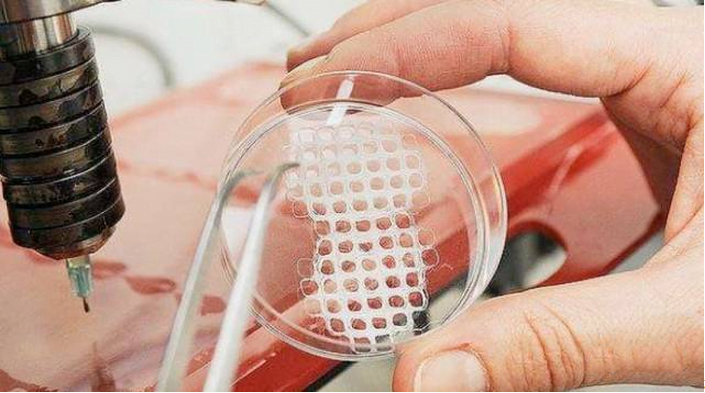
There are also many advantages to having a 3D printed body. Part of that is because it is easier to make than other alternatives. Companies such as Organovo, or Biobots have been doing and researching these alternatives for years. So don’t expect for this to come out for even private use for a while!
3D printing software is important when making something to be 3D printed.. Some people can get the best filament and 3D printer but forget that there is no way to print anything without an engine to print through! Some types of software are Fusion 360 Autodesk, TinkerCAD, and OpenSCAD. (Information from https://all3dp.com/1/best-free-3d-printing-software-3d-printer-program/)
| Name | Function | Difficulty level (To operate) | Platforms |
| TinkerCAD | Design | Beginner | Browser |
| Sculptris | Design | Beginner | Browser |
| Cura | Slicer, 3D printing Host | Beginner | Windows, Mac, Linux |
| Matter Control 2.0 | STL Editor, STL Repair, Cutter, 3D Printing Host | Beginner | Windows, Mac, Ubuntu, Raspberry Pi |
| Astroprint | Slicer, 3D printer host | Beginner | Browser |
| 3D Slash | Design | Beginner | Browser |
| TinkerCAD | Design | Beginner | Browser |
| Vectary | Design | Intermediate | Browser |
| Fusion360 | Design | Intermediate | Mac, Windows |
| FreeCAD | Design | Intermediate | Windows, Mac, Linux |
| OpenSCAD | Design | Intermediate | Windows, Mac, Linux |
| OctoPrint | Cutter, 3D Printer Host | Intermediate | Windows, Mac, Linux, Rasbian |
| Meshmixer | STL Editor, STL Repair | Intermediate | Windows, Mac |
| MakePrintable | STL Editor, STL Repair | Intermediate | Browser |
| Figuro | Design | Intermediate | Browser |
| SketchUp Free | Design | Intermediate | Browser |
| Netfabb | STL Repair, Cutter | Professional | Windows |
| MeshLab | Editor, STL Repair | Professional | Windows, Mac, Linux |
| Blender | Blender | Professional | Windows, Mac, Linux |
Here are some of the many applications of 3D printing:

And now, with the many challenges of having sufficient equipment to handle the caseload of the COVID-19 pandemic, some intrepid printers are modifying existing ventilators with a 3D printed part called a Y-splitter, which can help stretch the capabilities of the world’s limited supply of ventilators by dividing the air flow from a single ventilator to multiple patients. See article below:
https://www.cnn.com/2020/04/18/tech/us-coronavirus-ventilator-3d-printer-intl-hnk/index.html
Read More
Technology Central: Makerspace

By Jose Salamanca and Gideon Said
This year, the Makerspace lab has been utilized more than ever! Here, kids are allowed to work on any projects they want. In this room, there is a wide selection of materials from flight simulators to VR. You can 3-D print anything you need for whatever project you are pursuing. In this lab at the Science Academy, students are working on very unique and interesting projects. Many of them are direct solutions to modern world problems and other problems of all varieties. One project is a hexapod robot. A hexapod is a six-legged robot. The great thing about it is that you can code whatever movement styles you want! It can walk in a wave or shuffles and many other motions. Also, buying a ready-made hexapod would cost up to $2,000, while building it costs $200!
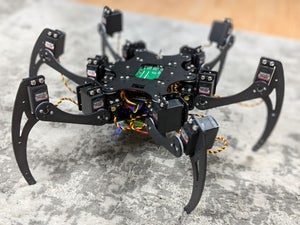
Another project is a VR Driving Simulator which stimulates the effects of drunk driving. It contains features that can change your reaction speed based on your blood toxicity. Also, it blurs the screen to make your vision worse based on the amount of alcohol coursing through you virtually.


Another project is a prosthetic arm that will be controlled with electrical impulses originating from your brain. This will allow the controlling of prosthetic limbs in injured people.

Regenerating concrete is another project trying to be completed. It could prevent against earthquakes and acid rain. The concrete would automatically regenerate itself from any cracks and/or fractures.

Another VR project is a surgery simulator that will be programmed with many different surgeries for medical students to practice on. This will contain many different operations widely used throughout the world on people. You will be able to practice and learn the correct methods when performing surgeries in real-life.
Another group will be designing an entire, interactive VR model of the school. You will be able to explore classrooms and hallways. All of these projects utilize the many capabilities of the Makerspace room. More details of these projects will be provided throughout the year as they develop and are built here in the Makerspace room.
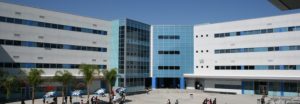
Marshmallow Challenge
Recently in Makerspace, there was a challenge where we had to create the tallest tower we could, using only one meter of string, twenty spaghetti sticks, and one meter of tape. This challenge tests your social capabilities and engineering skills under the pressure of time and limited, low-quality materials. On top of that, it has to hold a marshmallow on top so you have to hope that your marshmallow will not collapse AND be held higher than several other groups. Additionally, the tower has to be free-standing and can not be held for support. A short 18 minutes is all that is provided to the three/four-person group. The marshmallow challenge is mainly based on your skills in working together and breaking things down into simpler parts. This challenge requires clear communication and the ability to quickly start building instead of wasting precious time planning a design. Studies have shown how different types of people have different skill levels in doing this. Surprisingly, kindergartners have one of the highest scores because of how they put the marshmallow up first. Then they slowly add on, but the marshmallow is always on top. Many grades participated in this challenge. Our top record here in the Science Academy was an eighth-grade group at 27 inches tall!

Graph (top) Photo of Marshmallow Towers (bottom)

Read More

